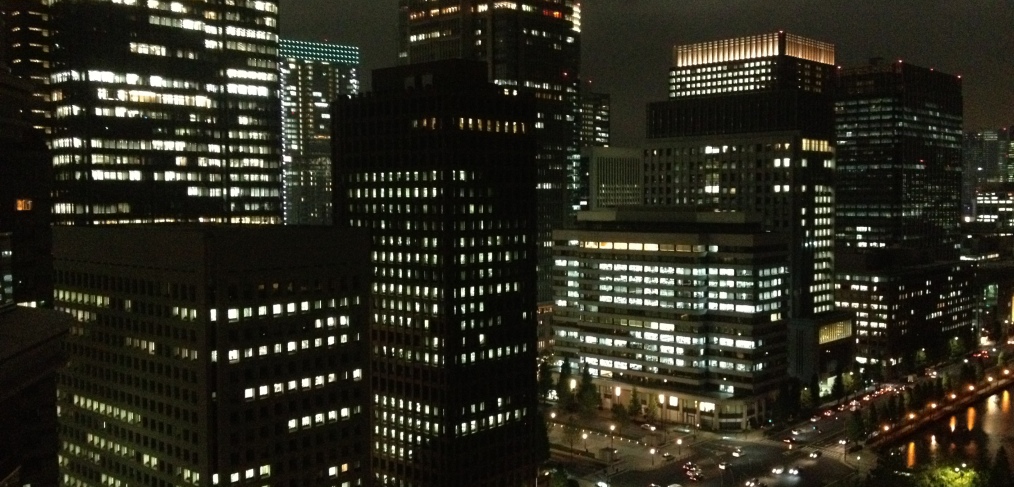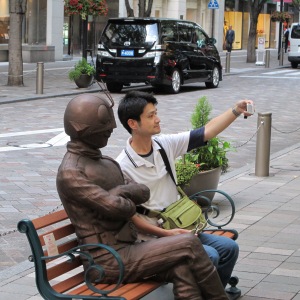
A Day in the Life of Marunouchi Tokyo
 With barely less than a day to spend in one of the largest cities in the world, Mark Bibby Jackson decides to invest his time in the financial district of Marunouchi and the wonderful Imperial Gardens to its west.
With barely less than a day to spend in one of the largest cities in the world, Mark Bibby Jackson decides to invest his time in the financial district of Marunouchi and the wonderful Imperial Gardens to its west.
My preconceived perception of Tokyo was one of skyscrapers, neon signs and sushi. But by midday on my first day in this metropolis of some 13 million people, I found myself sat in an oasis of calm surrounded by a small pond, herbaceous borders and ancient trees. I could have been in London if it were not for the humidity.
A short walk from Tokyo Station, the East Gardens of the Imperial Palace stand on the site of the former Edo Castle that dates back to 1603 when the Tokugawa Shoguns founded their capital here. Covering some 210,000 square metres, the gardens were part of a regeneration project for the Imperial Palace and opened to the public in 1968.
Entering through Otemon Gate, the first noise that greets me is that of young children practicing their martial arts in a small pagoda partly secluded by some hedges. Opposite the small Museum of the Imperial Collections (Sannomaru Shozokan) exhibits Yamaguchi Soken hanging scrolls from the mid-Edo period of the 18th century. A small building ahead is the first of many bansho dotted throughout the gardens. These were sentry posts for the samurai that protected the Emperor and the Imperial Palace.
However, it is not the many historical relics but the beautiful ornamental gardens that draw my attention. More like a London Park than New York’s Central Park, they provide a perfect respite for the weary office worker.
Even though she works just around the corner, today is the first time that Nadisa has visited the gardens.
“I have come here because I find it very relaxing,” she says.
Nadisa reminds me of my pre-Asian existence when I used to slip off from the office at lunchtime for a leisurely stroll around St James Park to eat a sandwich and watch the pelicans. There are no pelicans here and the sandwiches have morphed into sushi rolls, but many office workers have joined Nadisa to take advantage of this oasis of calm in the heart of the city. The soft rumble of the distant traffic is a reminder of the world that awaits us outside.
A steep slope (Shiomi-zaka) leads from the Ninomaru (second citadel) area of the gardens to the Honmaru (inner citadel) area. The remains of a tower allows a perfect vantage point to look down upon Ohoku, a manicured lawn where in Imperial times the Honmaru Gotun Palace was situated. Then you could see all the way to the sea from here, something I find hard to envisage as I cast my eye upon Tokyo’s sprawling city landscape.
Droves of tourists and families are taking advantage of the picnic-friendly environment.
Kyoko Tsukahra, 74, lives about an hour from Tokyo. She visits the Gardens once or twice a year.
“I want to walk around the Imperial Gardens,” she says. “It is a very calm and beautiful place. I like it very much.”
The gardens lie to the west of Marunouchi. Meaning “inside the circle”, its name refers to a time when the area lay within the outer moat of the Imperial Palace. Now one of the city’s main financial districts and the headquarters for Japan’s three largest banks, the district is seeing something of a revival as a cultural and culinary centre.
At the heart of this lies Marunouchi-Nakadori. A tree-lined street that would not look lost in Manhattan, designer clothes shops nestle beside streetside bistros. With tapas seemingly de rigueur here, it is even easier to forget you are in the Far East rather than Upper East Side.
The art literally spills out onto the street with bench sculptures and miniature gardens invigorating the well-trod pavements. To the rear of the Mitsubishi Ichigokan Museum, itself a beautiful red-brick building dating back to 1894 with a wonderful café attached to it, is Brick Square. At least on this sunny day, the small, enclosed garden is full of office workers enjoying an extended — it is 3pm by now — lunch. Wine bars, waffle shops and yet more tapas indicate there is more to Tokyo cuisine than raw fish and glutinous rice.
The night before I had arrived by taking the Tokyo Monorail from Haneda Airport to the main Tokyo Station, changing at Hamamatsucho. As droves of commuters stood taking photographs of the admittedly impressive structure, my stereotype of Japanese behaviour — largely based on tourists in London and American movies — became reinforced. It was only later I learned my visit coincided with the grand reopening of the station that had been kept under cover for five years. The project had restored the 98-year-old station to its pre-war beauty.
So, as the sun begins to set I return to the station to reacquaint myself with the hordes gathered outside, this time with my camera in hand too. It is the first time I have seen more people gathered outside a station than huddled inside on over-crowded platforms and concourses.
Although, Marunouchi may lack the array of nightlife options as Roppongi or Shinjuku, it does have a post-work wining and dining atmosphere appropriate for a financial district.
By-passing the inviting restaurants, such as Garb and Trattoria Pagliaccio that draw me in with their siren offers of vintage wines and tuna steaks, I head for Kanpachi, a sushi restaurant that has been recommended by the local tourist centre. Located at the base of the Kunigiwa Shopping Mall, Kanpachi is empty as I enter. My total absence of Japanese proves a problem as I point at various fish hopeful that I have ordered octopus and tuna. The miso I am confident about. The fish come as anticipated, but the soup has a school of baby clams buried in its depths. This does not detract from the overall experience.
Leaving far from replete — after all this is Japanese cuisine — I walk to neighbouring Cava. Over a glass of Japanese malt whisky I chat with one of the managers, Tony, who has spent a few years in New York. The main attraction of the place is the cheap prices — all its drinks are 380 yen ($5)
“It’s popular with local people after work,” he says.
Right on queue, a group of office workers come in and order a round of cold Asahi. Whether it’s London, Tokyo or Bangkok, it seems there is one thing everyone fancies after a hard day’s work.

One comment